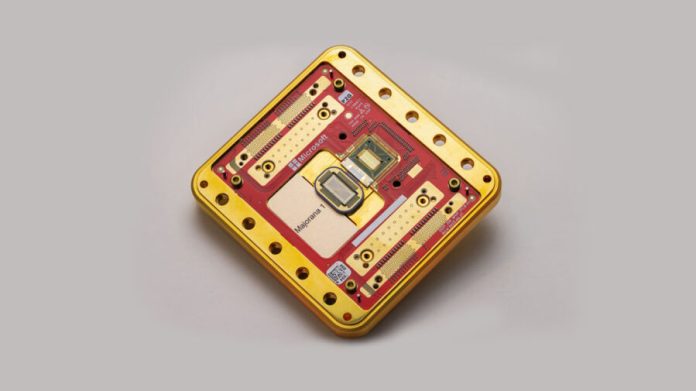Microsoft has unveiled a quantum processor that fits in the palm of your hand yet promises the computational power of a machine that would otherwise fill a football field. The new chip, dubbed Majorana 1, marks the first successful implementation of an entirely new state of matter, purpose-built for quantum computing.
The processor represents the culmination of a high-stakes, two-decade gamble by Microsoft to pursue an unconventional approach to quantum computing. Rather than following the industry standard, the company chose to develop “topological qubits” – quantum bits that are inherently more stable and easier to control than their conventional counterparts.
“We took a step back and said ‘OK, let’s invent the transistor for the quantum age. What properties does it need to have?’” said Chetan Nayak, Microsoft technical fellow. “And that’s really how we got here – it’s the particular combination, the quality and the important details in our new materials stack that have enabled a new kind of qubit and ultimately our entire architecture.”
At the heart of the innovation is a new class of materials called topoconductors, which create an exotic quantum state that’s neither solid, liquid, nor gas. This material hosts elusive particles known as Majoranas, which had never been seen in nature before Microsoft’s achievement. The breakthrough has been validated in a peer-reviewed paper published in Nature, confirming both the creation of these particles and the ability to measure their quantum states with unprecedented precision.
The implications extend far beyond the laboratory. The Majorana 1 chip is designed to scale to one million qubits, a threshold considered necessary for quantum computers to begin solving real-world problems. Current quantum computers typically work with dozens or hundreds of qubits.
“Whatever you’re doing in the quantum space needs to have a path to a million qubits. If it doesn’t, you’re going to hit a wall before you get to the scale at which you can solve the really important problems that motivate us,” Nayak explained. “We have actually worked out a path to a million.”
The achievement has caught the attention of DARPA, the Defense Advanced Research Projects Agency, which has selected Microsoft as one of only two companies to advance to the final phase of its program aimed at developing commercially viable quantum systems.
The technical challenges overcome by the Microsoft team are formidable. The chip’s materials had to be constructed atom by atom, with perfect alignment. “We are literally spraying atom by atom. Those materials have to line up perfectly. If there are too many defects in the material stack, it just kills your qubit,” said Krysta Svore, Microsoft technical fellow.
The potential applications span multiple industries. A million-qubit quantum computer could potentially design self-healing materials for bridges and airplane parts, develop catalysts to break down microplastics, or optimize enzymes to boost crop yields in harsh climates. The technology could even revolutionize product development by enabling perfect first-time designs.
“Any company that makes anything could just design it perfectly the first time out. It would just give you the answer,” said Matthias Troyer, Microsoft technical fellow. “The quantum computer teaches the AI the language of nature so the AI can just tell you the recipe for what you want to make.”
While the Majorana 1 currently houses eight topological qubits, its architecture is designed to scale to a million. The chip’s unique H-shaped wire arrangement allows qubits to be tiled across the processor like a microscopic mosaic. Unlike other quantum approaches that require complex analog controls for each qubit, Microsoft’s system can be controlled digitally – more like flipping a light switch than fine-tuning a radio dial.
The technology still faces engineering challenges before reaching its full potential. The quantum chip operates at temperatures colder than outer space and requires an ecosystem of control systems and software. However, the fundamental scientific hurdles have been cleared, suggesting that practical, large-scale quantum computing might arrive sooner than previously thought.
As Svore noted with a touch of irony, “With a scaled quantum computer, we will be able to predict materials with even better properties for building the next generation of quantum computers beyond scale.” It seems the future of quantum computing might just help design its own next chapter.
If you found this piece useful, please consider supporting our work with a small, one-time or monthly donation. Your contribution enables us to continue bringing you accurate, thought-provoking science and medical news that you can trust. Independent reporting takes time, effort, and resources, and your support makes it possible for us to keep exploring the stories that matter to you. Together, we can ensure that important discoveries and developments reach the people who need them most.






